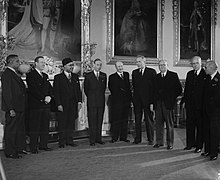
Back إعلان لندن Arabic Londona Deklaracio Esperanto הצהרת לונדון HE लंदन घोषणा Hindi Deklarasi London ID Dichiarazione di Londra Italian Deklarasi London Malay Declaração de Londres Portuguese இலண்டன் சாற்றுரை Tamil 伦敦宣言 Chinese

The London Declaration was a declaration issued by the 1949 Commonwealth Prime Ministers' Conference on the issue of India's continued membership of the Commonwealth of Nations, an association of independent states formerly part of the British Empire, after India's transition to a republican constitution.
Drafted by the Indian statesman V. K. Krishna Menon,[1] the declaration stated the agreement of the prime ministers to the continued membership of India in the organization after it becomes a republic. By that declaration, the Government of India had expressed its acceptance of the king as a symbol of the free association of its independent member nations and head of the Commonwealth.
The declaration dealt only with India, seen as an exceptional case, and it reaffirmed that the other members of the Commonwealth owed common allegiance to the Crown with an initial acceptance of the king as a head of the Commonwealth. However it did establish a precedent that republicanism is compatible with membership in the organization.[2]
- ^ Brecher cites the negotiations that led to the creation of the modern Commonwealth, Page 20 in Brecher’s India and World Politics: Krishna Menon’s View of the World, Oxford University Press, London 1968.
- ^ "although it was asserted that the case of India depended upon its own special circumstances, it has inevitably been regarded as having established a precedent. Common allegiance could not, after the Prime Ministers' Declaration of April, 1949, be posited as a fundamental rule of the Commonwealth association, though it is conceived that recognition of the Queen as " Head of the Commonwealth " is, at least for the present, such a rule. The constitutional status of the Members of the Commonwealth other than India was not intended to be changed by the 1949 Declaration; and the words of 1926 and 1931, reciting their " common allegiance to the Crown," were reaffirmed. S. A. de Smith, The Royal Styles and Titles, The International and Comparative Law Quarterly, April 1953, p. 265. JSTOR 755789
© MMXXIII Rich X Search. We shall prevail. All rights reserved. Rich X Search